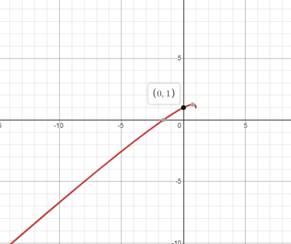
(a)
To find: Thevertical and horizontal asymptote of the function.
(a)
Answer to Problem 9RE
There is no Horizontal and vertical asymptote in the function.
Explanation of Solution
Given:
Concept used:
If the degree of the numerator is more than the denominator, there is no horizontal asymptote.
If the denominator has no zeroes then there has no vertical asymptotes.
Or
To get Vertical asymptote function should be rational and denominator must contain some variable otherwise there has no vertical asymptote.
Calculation:
Accordingto the laws of asymptotes:
If the degree of the numerator is more than the denominator, there is no horizontal asymptote.
If the denominator has no zeroes then there has no vertical asymptotes/.
Since her the function has denominator equal to one.
here the numerator of the function has degree 1 and denominator has degree of 0.
Hence, there is no Horizontal and vertical asymptote in the function.
(b)
To find: TheInterval of increasing or decreasing of the function.
(b)
Answer to Problem 9RE
The Interval of increasing or decreasing of the function is
Neither Decreasing nor increasing at interval of
Increasing at interval of
Explanation of Solution
Given:
Concept used:
Increasing or decreasing function can be calculated by equating first derivative of the function to 0.
Zeroes of x can be calculatedafter that the increasing and decreasing can be measured.
Calculation:
Increasing or decreasing function can be calculated by equating first derivative of the function to 0.
Hence the Interval of increasing or decreasing of the function is
Neither Decreasing nor increasing at interval of
Increasing at interval of
(c)
To find: The
(c)
Answer to Problem 9RE
Local
Explanation of Solution
Given:
Concept used:
The local maxima and minima can be calculated by firstly equating the double differentiation to 0.
1.
2.If
3.
Calculation:
At
Hence,
Local Maxima.
(d)
To find: Theinterval of concavity and the inflection point.
(d)
Answer to Problem 9RE
Concave downward in the interval of
Concave upward in the interval of
Explanation of Solution
Given:
Concept used:
The second derivative of function is calculated first.
Set the second derivative equal to zero and solve.
Check whether the second derivative undefined for any values of x.
Plot the number on number line and test the regions with the second derivative.
Plug these 3 values for obtain three inflection points.
The graph of
The graph of
If the graph of
Calculation:
By putting the values in the equation.
The interval will be
Hence,
Concave downward in the interval of
Concave upward in the interval of
(e)
To Sketch:the graph of the function using graphing device.
(e)
Answer to Problem 9RE
Through the graph it’s easily verified the point of local maxima and minima, function is increasing or decreasing, concavity down or up and point of inflection.
Explanation of Solution
Given:
Concept used:
Desmos graphing calculator is used her to plot the graph and it can easily verify the maxima, minima and point of inflection etc.
Calculation:
The graph of

Hence, through the graph it’s easily verified the point of local maxima and minima, function is increasing or decreasing, concavity down or up and point of inflection.
Chapter 4 Solutions
Single Variable Calculus: Concepts and Contexts, Enhanced Edition
- A 20 foot ladder rests on level ground; its head (top) is against a vertical wall. The bottom of the ladder begins by being 12 feet from the wall but begins moving away at the rate of 0.1 feet per second. At what rate is the top of the ladder slipping down the wall? You may use a calculator.arrow_forwardExplain the focus and reasons for establishment of 12.4.1(root test) and 12.4.2(ratio test)arrow_forwarduse Integration by Parts to derive 12.6.1arrow_forward
- Explain the relationship between 12.3.6, (case A of 12.3.6) and 12.3.7arrow_forwardExplain the key points and reasons for the establishment of 12.3.2(integral Test)arrow_forwardUse 12.4.2 to determine whether the infinite series on the right side of equation 12.6.5, 12.6.6 and 12.6.7 converges for every real number x.arrow_forward
- use Corollary 12.6.2 and 12.6.3 to derive 12.6.4,12.6.5, 12.6.6 and 12.6.7arrow_forwardExplain the focus and reasons for establishment of 12.5.1(lim(n->infinite) and sigma of k=0 to n)arrow_forwardExplain the focus and reasons for establishment of 12.5.3 about alternating series. and explain the reason why (sigma k=1 to infinite)(-1)k+1/k = 1/1 - 1/2 + 1/3 - 1/4 + .... converges.arrow_forward
 Calculus: Early TranscendentalsCalculusISBN:9781285741550Author:James StewartPublisher:Cengage Learning
Calculus: Early TranscendentalsCalculusISBN:9781285741550Author:James StewartPublisher:Cengage Learning Thomas' Calculus (14th Edition)CalculusISBN:9780134438986Author:Joel R. Hass, Christopher E. Heil, Maurice D. WeirPublisher:PEARSON
Thomas' Calculus (14th Edition)CalculusISBN:9780134438986Author:Joel R. Hass, Christopher E. Heil, Maurice D. WeirPublisher:PEARSON Calculus: Early Transcendentals (3rd Edition)CalculusISBN:9780134763644Author:William L. Briggs, Lyle Cochran, Bernard Gillett, Eric SchulzPublisher:PEARSON
Calculus: Early Transcendentals (3rd Edition)CalculusISBN:9780134763644Author:William L. Briggs, Lyle Cochran, Bernard Gillett, Eric SchulzPublisher:PEARSON Calculus: Early TranscendentalsCalculusISBN:9781319050740Author:Jon Rogawski, Colin Adams, Robert FranzosaPublisher:W. H. Freeman
Calculus: Early TranscendentalsCalculusISBN:9781319050740Author:Jon Rogawski, Colin Adams, Robert FranzosaPublisher:W. H. Freeman
 Calculus: Early Transcendental FunctionsCalculusISBN:9781337552516Author:Ron Larson, Bruce H. EdwardsPublisher:Cengage Learning
Calculus: Early Transcendental FunctionsCalculusISBN:9781337552516Author:Ron Larson, Bruce H. EdwardsPublisher:Cengage Learning





